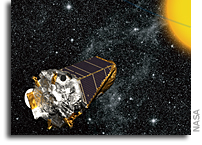The Abundance of Extraterrestrial Life After the Kepler Mission

The data recently accumulated by the Kepler mission have demonstrated that small planets are quite common and that a significant fraction of all stars may have an Earth-like planet within their Habitable Zone.
These results are combined with a Drake-equation formalism to derive the space density of biotic planets as a function of the relatively modest uncertainty in the astronomical data and of the (yet unknown) probability for the evolution of biotic life, Fb.
I suggest that Fb may be estimated by future spectral observations of exoplanet biomarkers. If Fb is in the range 0.001 — 1 then a biotic planet may be expected within 10 — 100 light years from Earth. Extending the biotic results to advanced life I derive expressions for the distance to putative civilizations in terms of two additional Drake parameters – the probability for evolution of a civilization, Fc, and its average longevity. For instance, assuming optimistic probability values (Fb Fc 1) and a broadcasting longevity of a few thousand years, the likely distance to the nearest civilizations detectable by SETI is of the order of a few thousand light years.
The probability of detecting intelligent signals with present and future radio telescopes is calculated as a function of the Drake parameters. Finally, I describe how the detection of intelligent signals would constrain the Drake parameters.
Amri Wandel (Submitted on 3 Dec 2014)
Comments: 12 pages, 3 figures, accepted for publication, International Journal of Astrobiology 2015
Subjects: Earth and Planetary Astrophysics (astro-ph.EP)
Cite as: arXiv:1412.1302 [astro-ph.EP] (or arXiv:1412.1302v1 [astro-ph.EP] for this version)
Submission history From: Amri Wandel [v1] Wed, 3 Dec 2014 12:40:34 GMT (600kb)








